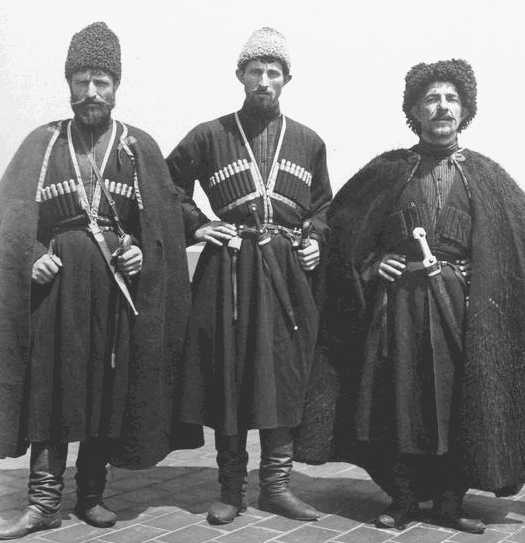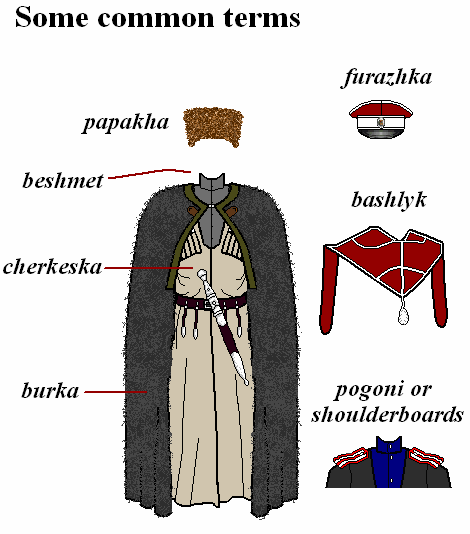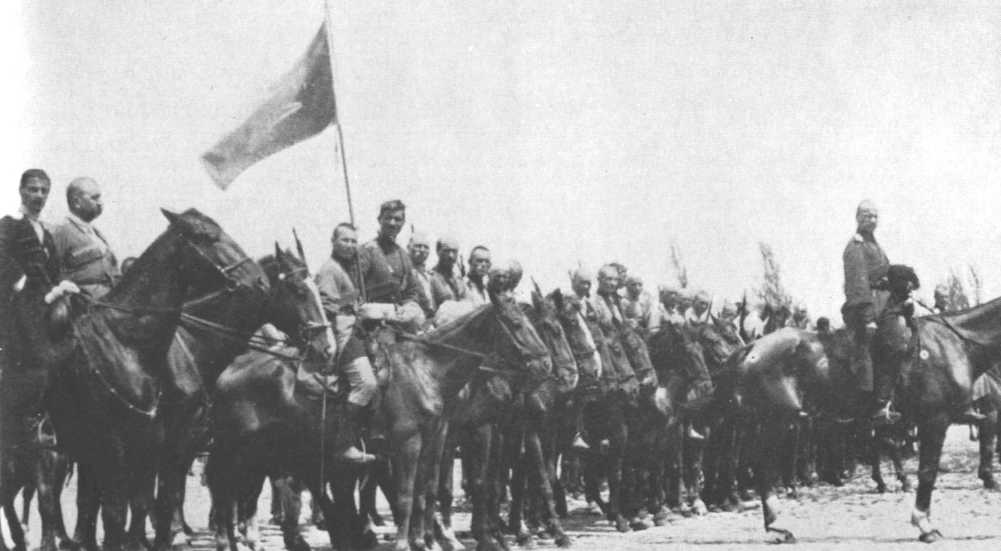
Mountain Dress

This was the dress of the tribesmen of the Caucasus, and most of the terms derive straight from their languages.
Tradition was that Cossacks provided their own equipment, which led to huge variations in style and colour. This fell by the wayside during WWI, as large amounts of material were unobtainable by civilians. Thus units are sometimes seen with identical colour and cut of garment from that war.
Basics
The key piece in the outfit is the cherkeska (sometimes a Circassian in English, as Russian does not particularly distinguish between the Cherkes tribe and Circassians in general). This is a long flowing outer garment, which came in both simple and highly ornate versions. The front was cut quite deeply, in either a V or U shape. On the breast were large ornamental cartridge holders (originally, of course, they had been functional), sometimes decorated with braid, or even metallic silver (on wooden rods).
Cherkeskas were never patterned, although they might have sleeves rolled back in contrasting colours. Generally they were in tones of grey to black; though tans, browns and dull reds were seen. Blues were very rare and greens never, except that ones made from military stock in WWI were sometimes khaki.
The cherkeska was originally a long garment, but over time it seems to have gotten progressively shorter. Men serving on foot had always worn a version that did not reach much over the knees anyway, and by the end of the Civil War many cavalry had also adopted this style.
Under this was worn a beshmet shirt, which could be quite vividly coloured, even in the field. These were unpatterned apart from the odd one with thin vertical stripes or small dots.
The belt was thin and often had straps for attaching further weapons. It too might have silver additions.
Trousers, though barely seen in the field, were standard baggy Cossack style, with uniform stripes in many cases.
The boots were high, soft, had little or no heel, and were worn without spurs (a nagaika whip being used instead).
Bad Weather Garments
A large dark burka cape reached down to near the ankles. Many were fur, the rest heavy wool.
A separate felt or wool bashlyk hood covered the head. The mountain Cossacks had these in host colours,nand they added a splash of colour to the units, even in the worst weather. When not in use the bashlyk was draped over the shoulders, sometimes with its long arms crossed on the chest.
In very cold weather felt valenki boots might be worn. There was also a sort of gaiter footwear with quite visible seams.

Hats
Although a peaked cap might be provided in the official uniform of the various units, in practice men in this dress seem to only ever have worn the papakha, the cylindrical woolen hat traditional to the Caucasus. Traditionally quite high, but not generally particularly shaggy.
Shortages of materials in WWI and beyond meant that a lower version became more current (sometimes termed a kubanka). The crown was cloth, generally in unit colours, with crossed cords for officers being common.
The fur was normally dark, but white and grey were common enough.
Weapons
The mountaineers, Kubans and Tereks fought primarily with swords when on horseback. The traditional shashka sabre is a thin, slightly curved sword with no hand guard but a large pommel.
Lances were never used by this era (even though standard in the rest of the Russian cavalry). Carbines were used by cavalry, and most men could shoot well.
The traditional outfit included a (sharp) dagger worn at the waist.
It was normal for men to equip themselves with spare weapons: particularly ornate pistols, daggers and swords if they could get them. Silver chasing was particularly popular. Williamson met some Kabardians on a train heading towards the front:
Dark unshaven men with Afghan appearance, they wore the long black waisted coat peculiar to the Kuban Cossacks, black or grey sheepskin caps, and an array of black-and-silver inlaid daggers, swords, old-fashioned pistols, and the usual decorative line of cartridges around the neck. Many had red bashliks, or hoods, hung around their neck to introduce a touch of colour, but all wore the red, blue and white chevrons of the White Army. ... [B]ecause I wasn't armed to the teeth, they seemed to find me an object mostly fit for derision.
Other
Almost all mountaineers, Kubans and Tereks had moustaches, and most short beards as well.

Source: Williamson